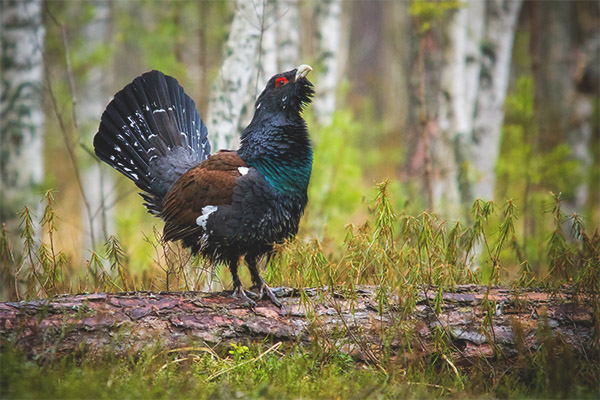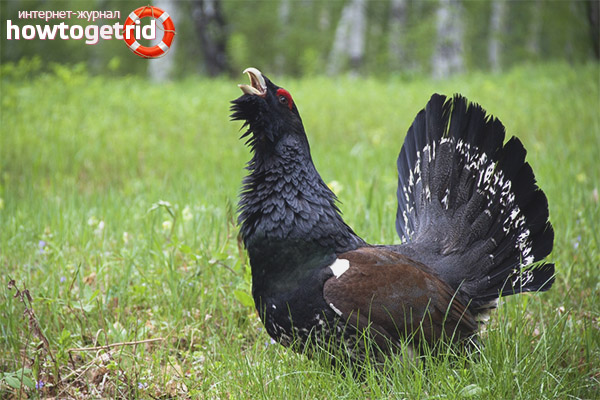The content of the article
The wood-grouse is the largest bird in the pheasant family. The halo of its habitat is found throughout Eurasia. The bird received its unusual name from hunters because of “deafness” and indifference to the events happening around it during the current period. And for this main reason it was easy to catch.
The wood-grouse is very beautiful, but heavy when flying bird. From the closest relatives in the family, it is distinguished by a majestic rounded tail of elongated feathers located near the throat. Females are relatively smaller than males in size. If males reach a weight of 4 - 6.5 kg, then the female barely weighs 2.
The average body length of a bird is within 110 cm and more, and its wingspan can reach 1.5 m.
Grouse plumage also differs according to gender. The male has black feathers on the head, front of the neck, as well as on the tail with splashes of white spots.The back of the neck has a more grayish color, and his body is black with brown and grayish spots. The craw and breast of the bird has a greenish tint. On wings brown plumage prevails more often. Above the bird's eyes is a patch of bare skin of a reddish hue.
Females, unlike males, have a more inconspicuous color. In their variegated plumage, they have rusty, reddish, green, black-brown and even pure white colors. They have an almost pure bright red tint only in the region of the throat, on the curves of the wings, and also on the breast.
Diet
Habitat
The wood-grouse differs by constancy in the choice of their refuge.Very rarely, they change it, flying away over long distances. During the day, the bird prefers to dwell on the earth, and at nightfall, it moves to the trees.
Until the 18th century, the capercaillie could be found everywhere throughout the Eurasian continent, but due to intensive hunting, its numbers in nature gradually decreased, and in some countries disappeared altogether. For example, in the UK, where they were exterminated by hunters, wood grouses had to be specially brought from Sweden.
Common species
Wood grouse in the world, there are only 16 subspecies, which differ only by a small difference in the color of their plumage. Stone grouse is considered the most recognizable of them.
The distribution halo of this species is located in Siberia. Its plumage is predominantly black in color with a bluish tint, interspersed with white spots near the wings and tail, the breast has a greenish ebb, and the beak is black. The females of the capercaillie have a darker color than the ordinary members of the family. This species is much more cautious in comparison with other species, since it does not “stall” during toking.
The main differences of the female from the male
It is very simple to distinguish a female from a male, as they have a pronounced sexual dimorphism. The females are noticeably smaller in size than the males and have a much more variegated coloration of their plumage with patches of red, yellow and white feathers. Males on the contrary - have greater uniformity of color in their plumage, which may contain black, gray or brown shades.
Breeding birds
The whole spring period in wood grouses is considered marriageable. They are polygamous birds, so sometimes the male can have a union not only with one female throughout life. During this period, the males begin to actively current. Even human hearing can catch their marriage song, as it spreads well even at a distance of 500 meters. The female, in connection with her sound range, can hear singing from a distance of 2 times greater than a person. During the performance of the marriage song, which lasts throughout the day, the male makes clicking sounds and a kind of crackling, designed to attract the female. During his toking, he ruffles feathers, throws back his head and, having closed his eyes, becomes absolutely "deaf" to what is happening around. In the meantime, females fly to his “call”.
The wood-grouse does not change the place for its toking. Every year at this time they flock to the same pieces of land, which are popularly known as tokischis. When the sounds arrive at the place where the female is toked, the males descend from the branches to the bottom closer to them. During their mating games, the males fight for the attention of the female, sometimes how fierce that reach the death of individual members of the species.
For the most part, the active tokening lasts about a month, after which the females start building a nest. With the construction of the birds are not particularly difficult, since the nest is usually a recess dug in the ground. Covered on top with pieces of grass, leaves, twigs or feathers, it can be under a tree or even close to the road. The number of eggs laid depends on the age of the female, and outwardly resembles a small chicken in size. If the female is young, then in the nest there may be about 5-8 eggs, and for an older individual - about 12-16. The eggs themselves are greyish-yellow with patches of brown and gray. Only the female incubates its offspring, and the incubation period for eggs ranges from 25 to 28 days.Nestlings are born not entirely helpless creatures, because immediately after their birth and drying, the gun can already follow on the heels of its parent. Of course, little chicks still have a little fluff to warm themselves, but a caring mother will always be there and share her warmth. She carefully guards her offspring. There were cases when the female, rescuing her chicks, rushed into danger, only in order to hide in a safe place.
The young itself grows very quickly. After only two weeks after their birth, the chicks are able to fly short distances on their own, and in a month they are already climbing trees and can begin to lead independent lives. For this reason, if the female dies, the chicks have a chance of survival.
With the onset of the autumn period, all grown males leave the mother, and the young females stay with her for some time.
Interesting Facts
- Throughout the 18th and 19th centuries, due to the peculiarities of its behavior during the spring mating season, the capercaillie became the favorite commercial and sporting and hunting prey.There were cases when the male did not hear the sounds of the first shots during his mating singing and let the person close to him.
- Wood grouse can produce joint offspring with their close relatives in the black grouse family. Nestlings from such a union are called "interbeds".
- In winter, they prefer to form small flocks and live in trees, but in severe frosts they can fall directly on the snow and make their nesting chamber in it, taking off only for feeding.
- Capercaillie before the onset of winter is stocked with stones. Because of the peculiarities of its nutrition in winter, when the bird switches to coarse food, such stones help the stomach to work. Otherwise, she may die.
Video: Capercaillie (Tetrao urogallus)













To send